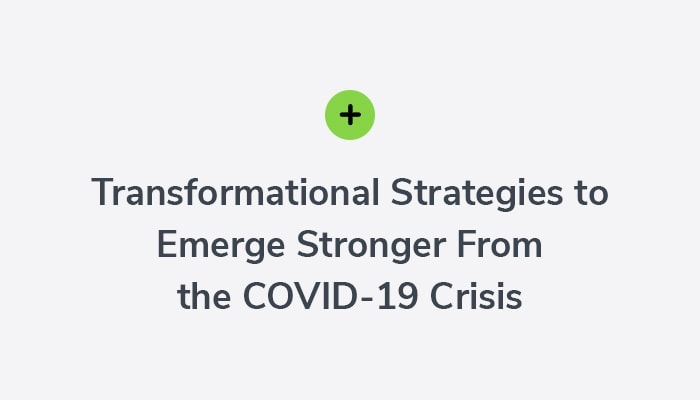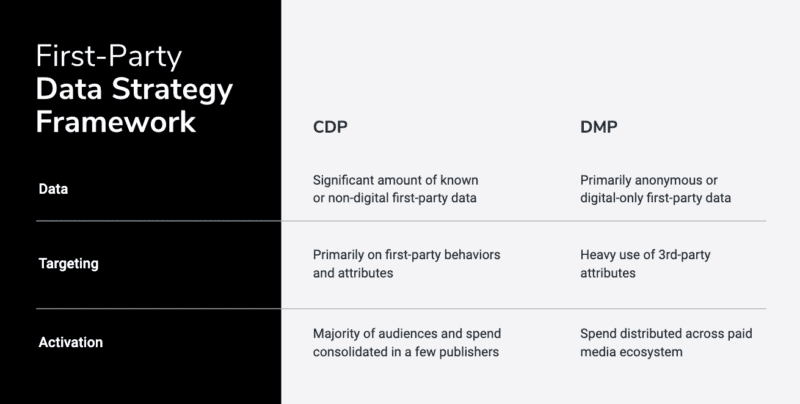Transformational Strategies to Emerge Stronger From the COVID-19 Crisis

As I discussed in my previous blog, 3 Strategies to Get Through the Next 90 Days, focusing on surviving in the near term is the highest priority for you as a business leader. But the best short-term plans also serve as a stepping stone to larger goals. Take this as an opportunity to take a clean look at your teams, tools and processes, and make some difficult but imperative decisions for your business that will benefit you in the long term and help you emerge stronger from the COVID-19 crisis.
In this piece, I’ll discuss some of the changes you can consider making right now. We’ll focus on two specific areas:
- Rationalizing your technology stack
- Streamlining marketing operations
1. Rationalize Your Tech Stack
Most businesses have significantly pulled back budgets in response to the evolving crisis. Based on what we’re hearing in the industry, you should assume this impact will last into the foreseeable future. That’s why it makes sense to look at cost savings that can pay dividends over the long haul.
Your tech stack is a good place to start. You’ll want to look at removing areas of redundancy wherever they exist. If you’re like many of our clients, you’ve been charting this course for a while—but it’s time to accelerate those efforts in order to start preserving more cash in this area as soon as possible.
Create Efficiency With a “Smart Hub, Dumb Spokes” Approach
Historically, marketers were forced to bundle disparate data and intelligence solutions alongside the delivery capability in each channel. This is true even with the large marketing clouds—whose data and channels are not fully integrated across their portfolio.
A customer data platform (CDP) enables you to centralize your analytics and audiences for all downstream systems, making your end-point delivery tools ripe for rationalization. Using the smart hub, dumb spokes strategy, you can either reduce—or completely offboard—the cost of your expensive execution tools.
Candidate tools to consider for rationalization using this approach include your:
- Email service provider (ESP)
- Data management platform (DMP)
- Trigger based marketing automation
Rationalizing Your Tech: ESP
Savings Potential: $500,000 – $1,000,000 annually
–
Opportunities
Consolidation
-
Organizations with multiple ESPs (some have 5 or more across different teams) can centralize audiencing into a CDP and use a single ESP to perform delivery.
Rationalization
-
Even a single ESP can become expensive if it’s used to manage data or build campaigns.
-
Centralizing data management, audiencing, and campaign management below your ESP removes these costs.
-
Rather than paying Salesforce $1MM+ for customer journeys, you can design truly omnichannel journeys using all of your data, for half the cost.
Migration
-
The most cost effective approach is to fully replace expensive ESPs with a CDP plus a lower cost email delivery vendor.
-
For example, ActionIQ partners with SparkPost, who sends over 30% of all emails across the world.
-
By combining a CDP and low cost ESP, you can significantly reduce your total cost, while increasing your capabilities at the same time.
–
Considerations
- A CDP takes over audience and campaign management from an ESP, but it does not deliver the emails. You still need an ESP to complement your CDP.
- Your CDP should plug into the ESP of your choice, but should also come with native integration to an ESP that’s best-in-class for delivery.
Rationalizing Your Tech: DMP
Savings Potential: $300,000 – $600,000 annually
–
Opportunities
Migration
- GDPR, browser cookie blockers, and consolidation of digital marketing spend to Facebook and Google have severely diminished the value of the DMP.
- If 80% of your digital marketing spend is happening in a handful of channels, then you can likely offboard your DMP.
–
Considerations
- You can use your CDP to activate known audiences directly into your channels such as Google and Facebook.
- To activate known to anonymous (cookie-based) audiences and send across a long-tail of DSPs, you can use a CDP + an onboarder like LiveRamp.
- Your CDP should be able to plug into your onboarder of choice.

Based on your acquisition marketing use cases, you may be able to streamline costs by using your CDP to take over the functions performed by your DMP today.
Watch this video to see how Pandora increased performance, reduced spend and created a continuous user experience by utilizing their CDP in place of the DMP.
Rationalizing Your Tech:
Marketing Automation – Triggers
Savings Potential: $200,000 – $400,000 annually
–
Opportunities
Migration
- Software tools to support web-based marketing triggers are point solutions serving a small number of use cases. They offer an initial bump in conversions (e.g. abandoned cart emails) but don’t have a long lasting impact on your customer strategy.
- Instead, use your CDP to ingest web clickstream and product details, and then trigger actions to an ESP in real time.
–
Considerations
- Along with this approach, you can reduce complexity and cost by completely centralizing your audience strategy—for both customer journeys and triggers—using your CDP.
- Some less common trigger use cases may not be supported by the CDP. To inform your decision to sunset the trigger software, calculate the business case for keeping the solution solely for those use cases.
The Bigger Picture on Tech Rationalization
A foundational technology like a CDP gives you a lot of flexibility and enhanced capability across your marketing stack. Using the hub-and-spoke versus bespoke stack approach reduces cost and complexity for the organization because it centralizes operations—saving you from repeating the work of audience management in each individual system.
2. Streamlining Marketing Operations
Just like your martech stack, your people and processes are unique to your organization. Many of your roles and processes have been defined around filling the gap between your marketing use cases and the capabilities of your technology. CDPs were built to close many of those gaps by introducing a data-first, business friendly platform.
The result is the opportunity to reduce inefficiencies, specifically in terms of manual effort done by internal and external resources. But you need to make changes in your roles and processes in order to see benefit. Through process reengineering, you can increase organizational speed and agility, while significantly reducing costs.
(For a deep dive on CDP-centric change management, download our eBook CDP Change Management Best Practices.)
Candidate areas of focus for increasing operational efficiency include:
- External agencies
- Internal data and analytics resources
- Internal IT projects
Streamlining Operational Costs:
Full Service Agencies
Savings Potential: $500,000 – $800,000 annually*
*Savings are inclusive of the cost of adding employees to your internal strategy and operations.
–
Opportunities
- Bring Outsourced Operations In-House
- In the past, companies outsourced data management and marketing operations to external vendors—these capabilities must now be a core competency for every organization.
- Use your CDP to take control of first-party data and the customer experience in-house.
- Data unification achieved with the CDP removes the need for extensive data management services.
- Self-service audiencing and campaign management allow you to achieve in minutes what previously took hours or days with an agency.
–
Considerations
- The CDP will eliminate the requirement for most data management and operations services, but you will need a process to handle occasional ad hoc requests.
- A CDP requires in-house talent to analyze strategies and design campaigns.
- If you don’t have or can’t bring those roles in-house, you shouldn’t migrate your external agency use cases to the CDP.
Streamlining Operational Costs:
Internal Data and Analytics Resources
Savings Potential: $800,000 – $1,200,000 annually
–
Opportunities
- Self-Service Business Layer
- Many large organizations rely on an army of internal resources across data science, BI, marketing analytics and CRM to support marketers’ insights, audiencing, and reporting needs.
- These specialized resources act as a translation layer between business teams setting marketing strategy and IT systems holding the customer data.
- A CDP automates much of the translation work currently performed by specialists, while also giving the business self-service access to data and insights.
- Your analytics experts are freed up to work on higher-value projects, and there’s no need to continue to grow their teams to scale to meet increasing marketing needs.
–
Considerations
- Translating data to customer attributes still requires an internal resource to select the data sets and define the translation rules.
- A best-in-class CDP enables your analyst to build attributes on-the-fly in the UI as a one-time task, eliminating repeat work each time marketing needs an audience.
See how Pandora created new operational efficiencies and better personalized experiences using their CDP to centralize audience management and enable business user self-service.
Streamlining Operational Costs:
Internal IT Projects
Savings Potential: $2,000,000 – $4,000,000 annually
–
Opportunities
- Productize and Scale Manual IT Projects
- Limitations in your marketing stack’s technical capabilities are generally overcome by the work of your IT team—but this work is expensive and time consuming, even for internal teams.
- For example, your marketing cloud requires a very specific format for your data and limits how much you can load. IT takes on the work of summarizing and transforming that data (for the marketing cloud and other systems that need the same data).
- The CDP provides a highly scalable layer between your IT systems and execution providers. It plugs directly into your data warehouse and other internal systems, absorbing the custom data transformation requirements across the entire stack.
- Your internal IT spend on marketing and analytics projects is reduced, while freeing up resources to work on other projects.
–
Considerations
- CDPs generally work with PII, so any solution will need to pass a rigorous infosec process.
The Bigger Picture on Streamlining Marketing Operations
By centralizing and streamlining your marketing operations, you are seizing a competitive advantage. The reduced manual and outsourced efforts across all your processes free up people and time so you can drive better customer experiences while reducing costs. The resulting increases in agility position you to more intelligently allocate budget across your channels and offers.
Read how international lifestyle brand Vera Bradley took control of the customer experience by bringing operations in-house—resulting in optimized spend, increased LTV, and higher margin sales.
Surviving and Thriving in the New Reality
In this blog I covered a number of areas across technology and operations where you can look to preserve cash and find new efficiencies. But the opportunity right now is bigger. It may be hard to realize it in the moment—as we are all focused on the challenges in front of us right now—but this crisis may be a chance for you to make the bold changes that have been needed for some time, even before COVID-19 hit. Take a hard look at all your tools, processes and teams, and accelerate the transformation your company needs in order to compete on customer experience in the future.
Next Steps
We’re here to help. If you’d like to talk through a strategy, the differences of CDP vs. DMP vs CDI, or learn how other brands have achieved some of the goals I talked about in this post, please get in touch. Use the “ask a question” box below and we’ll make sure you get connected with me or a colleague who can answer your questions.
You may also be interested in these additional resources:
- CX Leaders from Dunkin’, Gap, Theory on COVID-19 and the New Reality
- Surviving Now, Thriving Tomorrow
- CDP Change Management: Change Comes from Within





